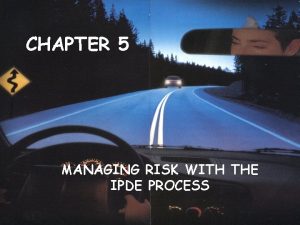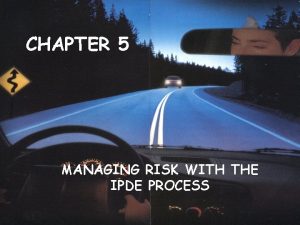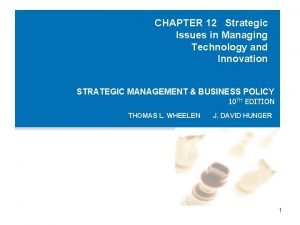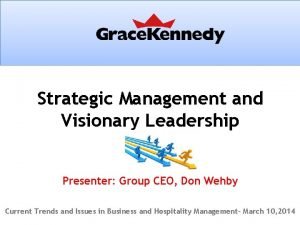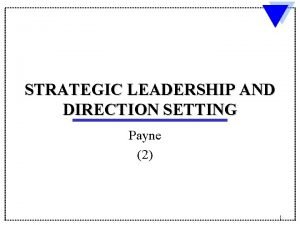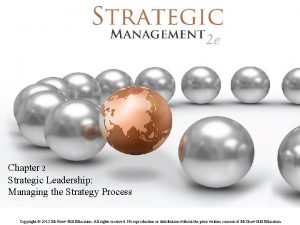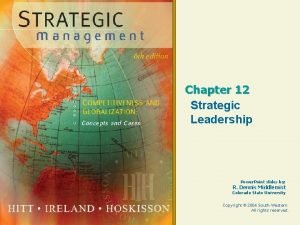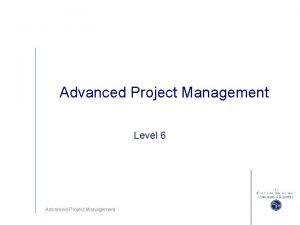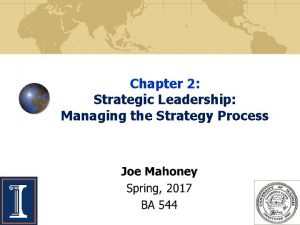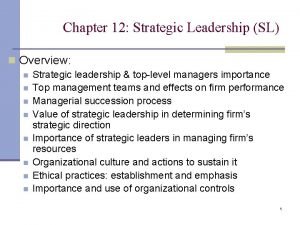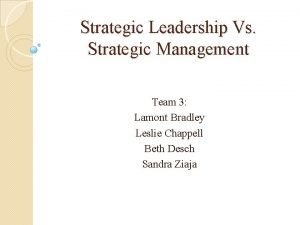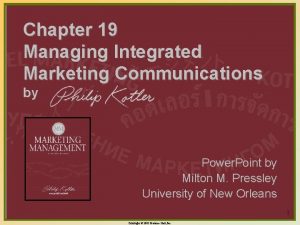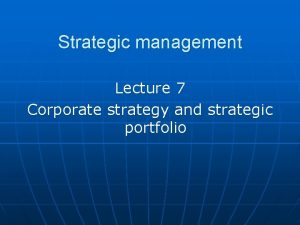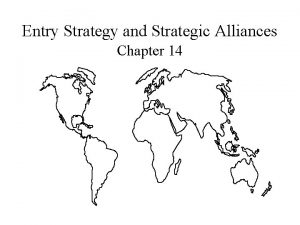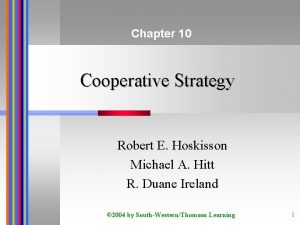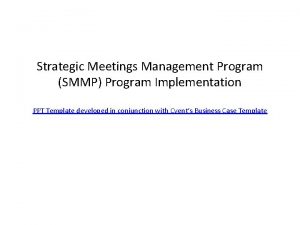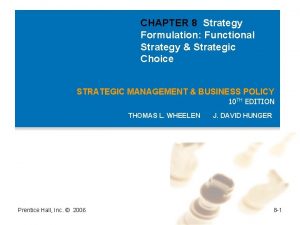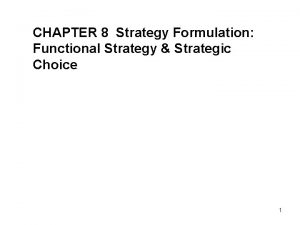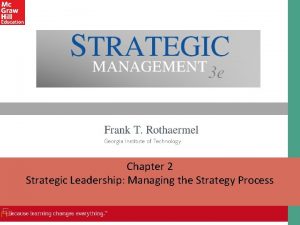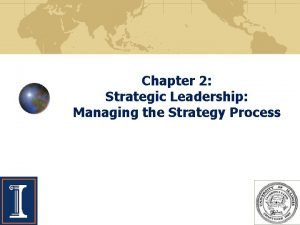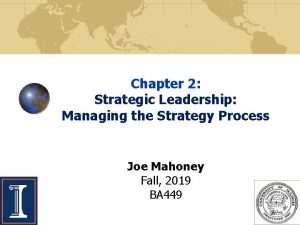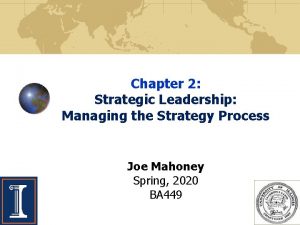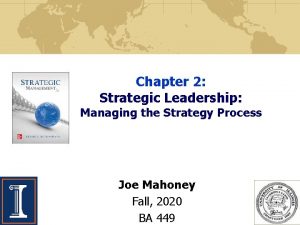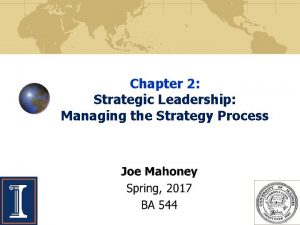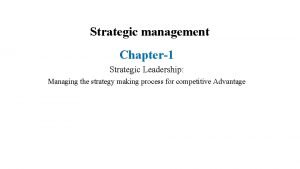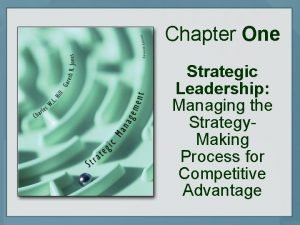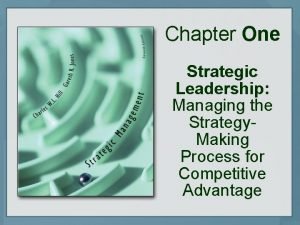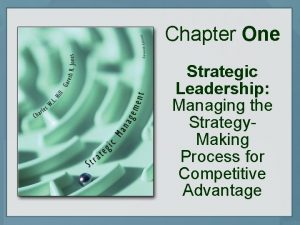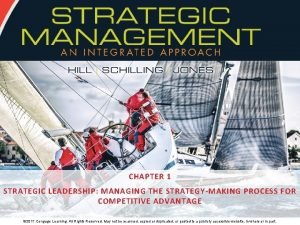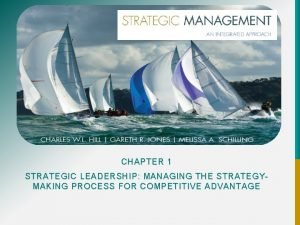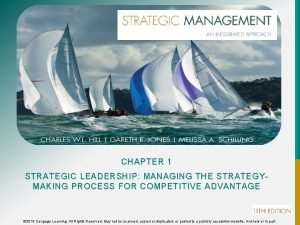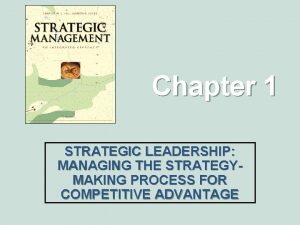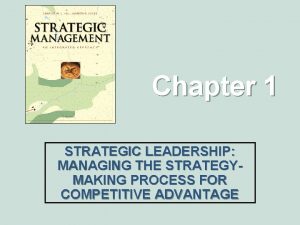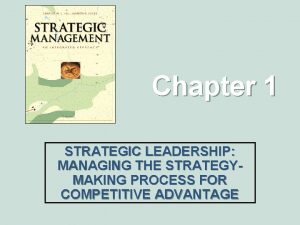Chapter 2 Strategic Leadership Managing the Strategy Process



































- Slides: 35

Chapter 2: Strategic Leadership: Managing the Strategy Process Joe Mahoney Fall, 2020 BA 449

Chapter 2: Case Highlight Leadership Crisis at Facebook • The End of the Zuckerberg-Sandberg Era? – By 2019, Facebook found itself caught in a perfect storm, and many were demanding that Zuckerberg and Sandberg step down. – Due to its lenient privacy controls, third parties were able to siphon off the personal data of tens of millions of Facebook users, lax data oversight also led to other alleged misdeeds, including the enabling of foreign interference during the 2016 U. S. presidential elections. Critics assert that because of its single-minded pursuit of exponential growth, Facebook’s leadership failed to consider the seriousness of negative side effects on the firm, its stakeholders, and its reputation. Copyright © 2017 by Mc. Graw-Hill Education. This is proprietary material solely for authorized instructor use. Not authorized for sale or distribution in any manner. This document may not be copied, scanned, duplicated, forwarded, distributed, or posted on a website, in whole or part. 2

Leaders Can Positively Impact Performance Mary Barra of General Motors Jeff Bezos of Amazon Elon Musk of Tesla and Space. X Phil Knight at Nike Indra Nooyi at Pepsi. Co Howard Schultz of Starbucks Oprah Winfrey of HARPO Mark Zuckerberg of Facebook © Mc. Graw Hill

Leaders Can Destroy Shareholder Value Bernard Ebbers of World. Com Richard Fuld of Lehman Brothers Ron Johnson of JC Penney Ken Lay of Enron Robert Nardelli of The Home Depot and Chrysler Charles Prince of Citigroup John Sculley of Apple Richard Wagoner of General Motors © Mc. Graw Hill

What Strategic Leaders Do Exhibit 2. 1 Source: Data from O. Bandiera, A. Prat, and R. Sadun (2012), “Management capital at the top: Evidence from the time use of CEOs, ” London School of Economics and Harvard Business School Working Paper. Access the text alternative for slide image. © Mc. Graw Hill

Strategic Leaders: The Level-5 Pyramid Exhibit 2. 2 Source: Adapted from Collins, J. (2001), Good to Great: Why Some Companies Make the Leap. . . And Others Don’t (New York: Harper. Collins), 20. Access the text alternative for slide image. © Mc. Graw Hill

Strategic Formulation and Implementation across Levels: Corporate, Business, and Functional Strategy Exhibit 2. 3 Source: Author’s creation based on Kahneman, D. (2011), Thinking, Fast and Slow (New York: Farrar, Straus and Giroux) Access the text alternative for slide image. © Mc. Graw Hill

Strategy Across the Levels • Where to Compete? Ø Should GE move more aggressively into the health care industry? • How to Compete? Ø Should GE jet engines have • CORPORATE STRATEGY • BUSINESS STRATEGY better fuel efficiency than Rolls Royce? • How to Implement? Ø Should GE human resources recruit more science graduates? • FUNCTIONAL STRATEGY

Levels of Strategy • Corporate Level: Typically involves decision-making by the top management team that includes the CEO, senior executives, the board of directors, and the corporate staff. Decisions include vertical integration, diversification, strategic alliances, acquisitions, new ventures, restructuring, and divestments. • Business Level: Includes the strategic choice of generic strategy (cost leadership, differentiation, focus) and the benefits and costs of first-mover advantages. Often an enterprise participating in multiple businesses will have different business strategies. • Functional Level: Typically directed at improving the effectiveness of functional operations within a company, such as manufacturing, materials management, human resources, marketing, R&D, and operations management. 1– 9

10

11 Strategy Highlight 2. 1 Teach for America: How Wendy Kopp Inspires Future Leaders • Vision, Mission, Values, Strategic Intent – Teach for America (TFA) is a non-profit organization of future leaders that works to ensure that under-privileged youth obtain an excellent education. TFA corp. members spend two years teaching in economically disadvantaged communities across the United States. – A study commissioned by the U. S. Department of Education found that students being taught by TFA corps. members showed significantly higher achievement, especially in math and science. Copyright © 2017 by Mc. Graw-Hill Education. This is proprietary material solely for authorized instructor use. Not authorized for sale or distribution in any manner. This document may not be copied, scanned, duplicated, forwarded, distributed, or posted on a website, in whole or part.

Defining the Business: The Starting Point of Strategy • Example: Fall of the Railroads Ø “They let others take customers away from them because they assumed themselves to be in the railroad business rather than in the transportation business. The reason they defined their industry wrong was because they were railroad oriented instead of transport oriented; they were product oriented instead of customer oriented. ” Theodore Levitt “Market Myopia” 2– 12

Product-Oriented Vision Statement • Defines a business in terms of a good or service provided • Example: “We are in the typewriter business” – Less flexible – Is not needs-based – Can lead to a myopic view Copyright © 2017 by Mc. Graw-Hill Education. This is proprietary material solely for authorized instructor use. Not authorized for sale or distribution in any manner. This document may not be copied, scanned, duplicated, forwarded, distributed, or posted on a website, in whole or part.

Customer-Oriented Vision Statement • Defines a business in terms of providing solutions to customer needs • Example: – Nike: “To bring inspiration and innovation to every athlete in the world” (p. 43). Copyright © 2017 by Mc. Graw-Hill Education. This is proprietary material solely for authorized instructor use. Not authorized for sale or distribution in any manner. This document may not be copied, scanned, duplicated, forwarded, distributed, or posted on a website, in whole or part.

Examples of Customer Oriented Vision Statements Company Vision Statement Alibaba To make it easy to do business anywhere. Amazon To be Earth’s most customer-centric company, where customers can find and discover anything they might want to buy online. Better World Books To harness the power of capitalism to bring literacy and opportunity to people around the world. Facebook To make the world more open and connected. GE To move, cure, build and power the world. Google To organize the world’s information and make it universally accessible and useful. Nike To bring inspiration and innovation to every athlete in the world. Space. X To accelerate the world’s transition to sustainable energy. Tesla To be the best retailer in the hearts and minds of consumers and employees. © Mc. Graw Hill

16 Three Approaches to Strategize for Competitive Advantage • Strategic planning – A formal, top-down planning approach • Scenario planning – A formal, top-down planning approach • Strategy as planned emergence – Begins with a strategic plan, less formal Copyright © 2017 by Mc. Graw-Hill Education. This is proprietary material solely for authorized instructor use. Not authorized for sale or distribution in any manner. This document may not be copied, scanned, duplicated, forwarded, distributed, or posted on a website, in whole or part.

Top-Down Strategic Planning in the AFI Strategy Framework Exhibit 2. 5 Access the text alternative for slide image. © Mc. Graw Hill

Shortcomings of the Top-Down Approach • May not adapt well to change • Formulation separate from implementation • Information flows top-down (one-way) • The leadership team’s future vision can be wrong • Example of a Top-Down Approach: Apple – Steve Jobs predicted customers needs and was one of the few successful technology companies using a top -down planning process. Copyright © 2017 by Mc. Graw-Hill Education. This is proprietary material solely for authorized instructor use. Not authorized for sale or distribution in any manner. This document may not be copied, scanned, duplicated, forwarded, distributed, or posted on a website, in whole or part.

Scenario Planning within the AFI Strategy Framework Exhibit 2. 6 Access the text alternative for slide image. © Mc. Graw Hill

Strategy as Scenario Planning • Scenario planning Ø Envision different "what-if" plans New laws. v Demographic shifts. v Changing economic conditions. v Technological advances. v Ø Generates a dominant strategic plan v Must implement the most probable option Ø Good example of scenario planning v Shell

Black Swan Events The high impact of a highly improbable event. It can affect strategic planning In the past, most people assumed all swans were white. • When they first encountered swans that were black, they were surprised. Examples: • Security breach of an IT system. • Accounting scandals: Enron. • Real estate bubble: 2008 financial crisis. • British exit from the European Union (Brexit) © Mc. Graw Hill

22 Strategy as Planned Emergence • Top Down and Bottom Up – Bottom-up strategic initiatives emerge – Evaluated & coordinated by management • Relies on data, plus: – Personal experience – Deep domain expertise – Front line employee insights Copyright © 2017 by Mc. Graw-Hill Education. This is proprietary material solely for authorized instructor use. Not authorized for sale or distribution in any manner. This document may not be copied, scanned, duplicated, forwarded, distributed, or posted on a website, in whole or part.

23

Strategic Initiatives and Serendipity • Japan Railways Ø Constructing a bullet train through the mountains north of Tokyo, which required many tunnels Ø Persistent flooding Ø Complex engineering plans to drain the water Ø Maintenance worker suggested that the fresh water off the mountains should not be drained, but rather should be bottled Ø 1, 000 vending machines on 1, 000 railroad platforms in and around Tokyo, and home delivery of water, juices, and coffee followed. Ø The employee’s proposal had turned this “bottom-up” strategy into a multi-million dollar business. 2– 24

Strategy Highlight 2. 2 Starbuck’s Frappuccino • Diana – Starbucks store manager in California – Received requests for iced beverage – Tried the beverage, and liked it • Requested Starbucks HQ offer the drink – Request denied; She did it anyway • Sales skyrocketed – Was eventually adopted by Starbucks Executives • This is now the Starbucks Frappuccino – At one point, was 20% of Starbucks’ revenues, which were $26 billion Copyright © 2017 by Mc. Graw-Hill Education. This is proprietary material solely for authorized instructor use. Not authorized for sale or distribution in any manner. This document may not be copied, scanned, duplicated, forwarded, distributed, or posted on a website, in whole or part. 25

26

27

Two Distinct Modes of Decision Making System 1 System 2 Fast Slow Unconscious Conscious Automatic Effortful Everyday, Snap Decisions Complex, Analytical Decisions Error Prone, Higher Likelihood of Biases Reliable, Lower Likelihood of Biases Exhibit 2. 9 Source: Author’s creation based on Kahneman, D. (2011), Thinking, Fast and Slow (New York: Farrar, Straus and Giroux) © Mc. Graw Hill

29

Cognitive Biases Bias: Description: Illusion of Control Our tendency to overestimate our ability to control events. Example: Air traffic controllers (p. 59) Escalating Commitment Continuing to support a course of action when it is showing signs that it may not succeed. Example: Escalation of Vietnam War. Confirmation Bias Searching for information to support existing beliefs, which is sometimes called prior hypothesis bias. Example: Market share leads to higher profitability Reason by Analogy The tendency to use simple analogies to make sense out of complex problems. Example: Domino theory of countries falling Representativeness Drawing conclusions based on small samples or anecdotes. Example: Depression after World War I Groupthink When opinions coalesce around a leader without individuals critically evaluating and challenging that leader’s opinions and assumptions. Example: Bay of Pigs Fiasco (Kennedy Administration) © Mc. Graw Hill

31

32

2– 33

How to Use a Devil’s Advocate to Improve Strategic Decision Making Exhibit 2. 10 © Mc. Graw Hill Example: Amazon (p. 62).

How to Use Dialectic Inquiry to Improve Strategic Decision Making Exhibit 2. 11 © Mc. Graw Hill
 Masterful strategies come from
Masterful strategies come from Chapter 5 managing risk with the ipde process
Chapter 5 managing risk with the ipde process Ipde process
Ipde process Managing risk with the ipde process
Managing risk with the ipde process You should practice your orderly visual search pattern
You should practice your orderly visual search pattern Chapter 4 managing risk with the ipde process
Chapter 4 managing risk with the ipde process Strategic issues in managing technology and innovation
Strategic issues in managing technology and innovation Strategic fit vs strategic intent
Strategic fit vs strategic intent Strategic complements and substitutes
Strategic complements and substitutes Resource based model
Resource based model Tows matrix
Tows matrix Visionary leadership and strategic management
Visionary leadership and strategic management Strategic leadership
Strategic leadership Customer oriented visions
Customer oriented visions Key strategic leadership actions
Key strategic leadership actions Maylor four stage model
Maylor four stage model Afi framework
Afi framework Key strategic leadership actions
Key strategic leadership actions Cost leadership in strategic management
Cost leadership in strategic management Leadership vs management
Leadership vs management Strategic leadership roles
Strategic leadership roles Strategic leadership challenges
Strategic leadership challenges Transactional vs transformational
Transactional vs transformational Adaptive leadership
Adaptive leadership Enthusiastic beginner disillusioned learner
Enthusiastic beginner disillusioned learner Designing and managing integrated marketing channels
Designing and managing integrated marketing channels A functional strategy
A functional strategy What is corporate strategy in strategic management
What is corporate strategy in strategic management Corporate strategy growth stability retrenchment
Corporate strategy growth stability retrenchment Entry strategy and strategic alliances
Entry strategy and strategic alliances Corporate level cooperative strategy
Corporate level cooperative strategy Strategic meeting management program
Strategic meeting management program Factors affecting strategic choice
Factors affecting strategic choice Factors affecting strategic choice
Factors affecting strategic choice Market entry modes for international businesses chapter 7
Market entry modes for international businesses chapter 7 Making strategy: mapping out strategic success
Making strategy: mapping out strategic success

